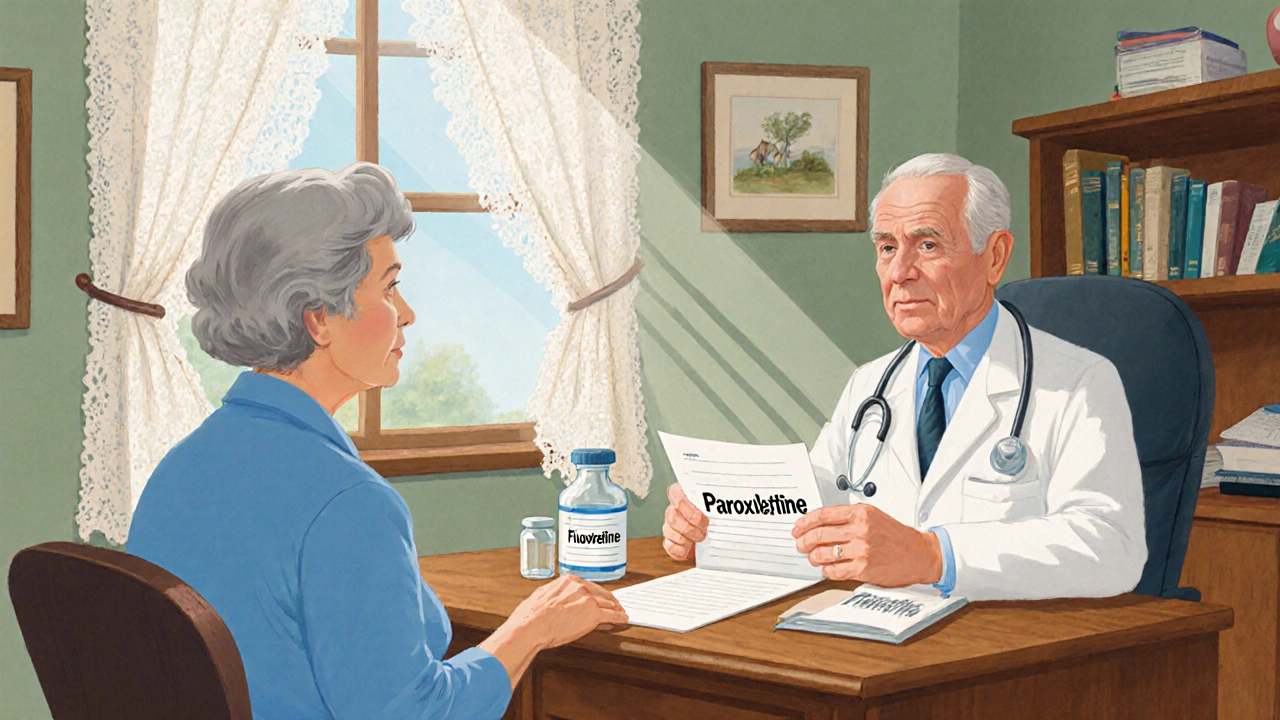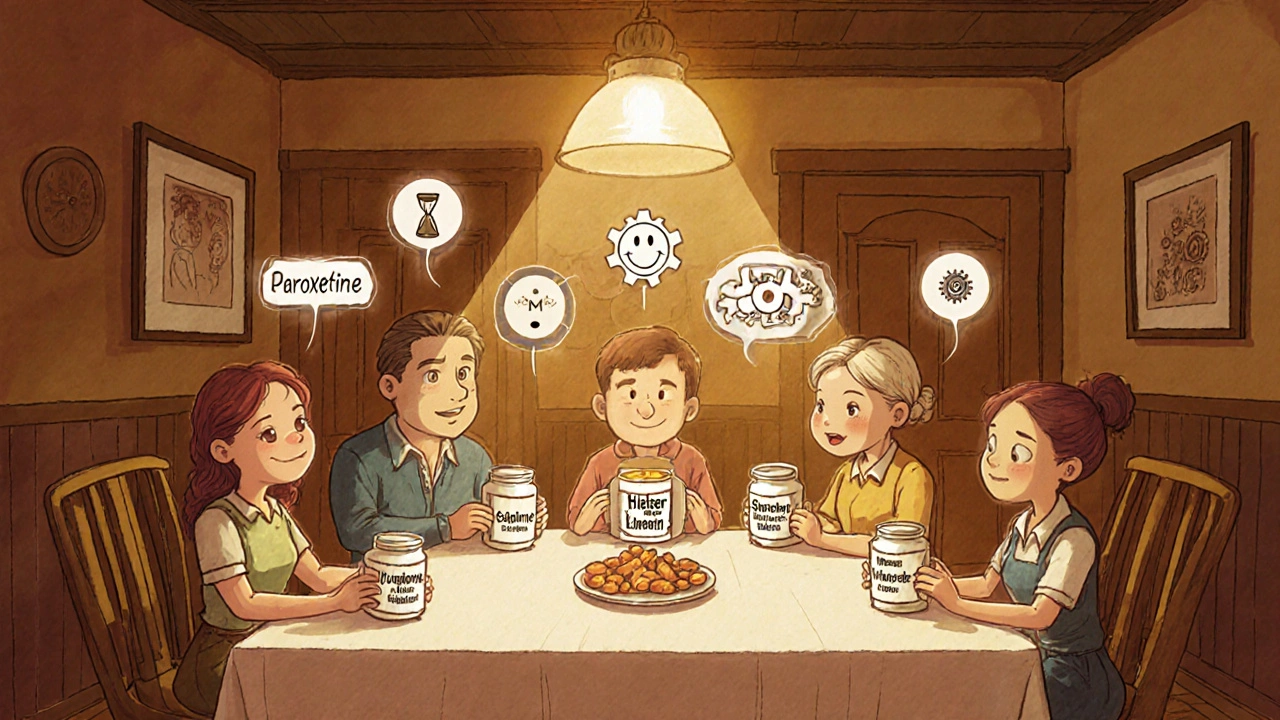Paroxetine vs Other Antidepressants: Comparing Alternatives
 Oct, 18 2025
Oct, 18 2025
Antidepressant Selection Guide
Compare paroxetine with other antidepressants based on your specific needs and concerns.
Your Selection Criteria
Key Takeaways
- Paroxetine is an SSRI with a short half‑life and a higher risk of withdrawal symptoms.
- Fluoxetine and sertraline are often preferred for patients who need a longer half‑life.
- Escitalopram offers a very clean side‑effect profile, making it a go‑to for many clinicians.
- Venlafaxine and duloxetine are SNRIs that add norepinephrine relief, useful when anxiety or pain is prominent.
- Switching between antidepressants requires a taper plan, monitoring, and sometimes a wash‑out period.
What Is Paroxetine?
When doctors prescribe antidepressants, Paroxetine is a selective serotonin reuptake inhibitor (SSRI) that raises serotonin levels in the brain by blocking its reabsorption. Approved by the FDA in 1992, it’s marketed under brand names like Paxil and Seroxat. The typical adult dose ranges from 10 mg to 60 mg daily, and it’s used for major depressive disorder, generalized anxiety, panic disorder, social anxiety, and post‑traumatic stress disorder.
Pharmacokinetically, paroxetine has a half‑life of roughly 21 hours, which means the drug clears from the system relatively quickly. This short half‑life contributes to its notorious discontinuation syndrome: patients who stop abruptly may feel dizziness, electric‑shock sensations, and mood swings within a few days.
How Paroxetine Works
Paroxetine binds to the serotonin transporter (SERT) located on presynaptic neurons. By inhibiting SERT, more serotonin stays in the synaptic cleft, boosting neurotransmission. The increased serotonin helps correct the mood‑regulating imbalance thought to underlie depression and anxiety. Unlike some older SSRIs, paroxetine also has mild anticholinergic activity, which can cause dry mouth and constipation in sensitive patients.

When to Consider Alternatives
Even though paroxetine is effective for many, several factors push clinicians toward other options:
- Withdrawal risk: The short half‑life makes tapering tricky.
- Drug interactions: Paroxetine strongly inhibits CYP2D6, raising levels of many co‑prescribed drugs.
- Sexual side effects: Patients often report decreased libido and delayed orgasm.
- Weight gain: Longer‑term use can lead to modest weight increases.
If any of these issues are a concern, looking at alternatives that have a longer half‑life, fewer CYP interactions, or a different side‑effect fingerprint makes sense.
Side‑by‑Side Comparison
| Drug | Class | Half‑life | Typical Daily Dose | Common Side Effects | Notable CYP Interactions |
|---|---|---|---|---|---|
| Paroxetine | SSRI | ≈21 h | 10‑60 mg | Sexual dysfunction, nausea, dry mouth | Strong CYP2D6 inhibitor |
| Fluoxetine | SSRI | ≈4‑6 days | 20‑80 mg | Insomnia, agitation, GI upset | Moderate CYP2D6 inhibitor |
| Sertraline | SSRI | ≈26 h | 50‑200 mg | Diarrhea, sexual dysfunction, dizziness | Weak CYP2D6 inhibitor |
| Escitalopram | SSRI | ≈27‑32 h | 10‑20 mg | Nausea, headache, fatigue | Minimal CYP interaction |
| Venlafaxine | SNRI | ≈5 h (extended‑release ~11 h) | 75‑375 mg (XR) | Hypertension, nausea, sexual dysfunction | Inhibits CYP2D6 (moderate) |
| Duloxetine | SNRI | ≈12 h | 30‑120 mg | Dry mouth, constipation, insomnia | Inhibits CYP1A2, CYP2D6 |

Deep Dive Into Each Alternative
Fluoxetine
Fluoxetine’s long half‑life makes it forgiving during missed doses and reduces the severity of withdrawal. It’s a solid choice for patients prone to non‑adherence. However, its activating side‑effects-especially insomnia-can be problematic for those with anxiety‑dominant presentations.
Sertraline
Sertraline balances efficacy with a relatively mild side‑effect profile. It’s often the first‑line SSRI for both depression and obsessive‑compulsive disorder. Its weak CYP2D6 inhibition means fewer drug-drug interactions, which is a plus for polypharmacy patients.
Escitalopram
Escitalopram is the S‑enantiomer of citalopram, giving it higher serotonin affinity and fewer off‑target actions. Clinical trials show comparable remission rates to other SSRIs but with less sexual dysfunction and weight gain. It’s a go‑to when tolerability is the primary concern.
Venlafaxine
As an SNRI, venlafaxine adds norepinephrine reuptake inhibition at higher doses, helping patients with mixed depressive‑anxiety or pain syndromes. Blood pressure monitoring is essential because dose‑related hypertension can emerge.
Duloxetine
Duloxetine shines in treating both depression and chronic pain (e.g., diabetic neuropathy, fibromyalgia). Its moderate half‑life avoids the abrupt withdrawal seen with paroxetine, yet it still requires careful tapering.
Choosing the Right Antidepressant: A Practical Guide
- Assess the side‑effect priority: If sexual dysfunction is a deal‑breaker, escitalopram or sertraline may be safer.
- Consider comorbid conditions: Chronic pain points toward duloxetine; hypertension calls for caution with venlafaxine.
- Review current medications: Strong CYP2D6 inhibitors (e.g., certain antipsychotics) limit paroxetine’s use.
- Think about adherence: Long half‑life agents like fluoxetine forgive occasional missed doses.
- Factor in cost and insurance coverage: Generic versions of sertraline and fluoxetine are often the cheapest options.
By walking through these checkpoints, you can narrow down the list from a dozen possibilities to the one that aligns best with the patient’s medical history and lifestyle.
Tips for Switching Antidepressants Safely
- Never stop paroxetine abruptly; taper by 10‑20 mg per week when feasible.
- If the next drug has a long half‑life (e.g., fluoxetine), a direct cross‑tap may be possible after a minimal wash‑out.
- Monitor for serotonin syndrome when overlapping serotonergic agents, even for a few days.
- Schedule a follow‑up within 1‑2 weeks of the switch to adjust dose and address emerging side effects.
- Educate the patient about expected transient symptoms (headache, mild nausea) that usually resolve in 1‑2 weeks.
How long does it take for paroxetine withdrawal symptoms to appear?
Withdrawal can start as early as 24 hours after the last dose, peaking around 3‑5 days, and may last a few weeks if not tapered properly.
Is paroxetine safe to use during pregnancy?
Paroxetine is classified as Pregnancy Category D in the U.S., meaning potential risks to the fetus have been observed. Clinicians usually prefer other SSRIs with a safer profile for pregnant patients.
What makes fluoxetine a better option for patients who miss doses?
Fluoxetine’s half‑life of 4‑6 days means the drug stays in the system for weeks, smoothing out occasional missed doses and reducing withdrawal risk.
Can I combine paroxetine with over‑the‑counter sleep aids?
Combining paroxetine with antihistamine‑based sleep aids (e.g., diphenhydramine) is generally safe, but mixing it with melatonin or herbal sedatives should be discussed with a physician to avoid excessive sedation.
How do I know if I need to switch from paroxetine to an SNRI?
If depression is accompanied by chronic pain, high‑level anxiety, or low energy that isn’t improving after 6‑8 weeks, an SNRI like duloxetine or venlafaxine may provide additional norepinephrine support.

dennis turcios
October 18, 2025 AT 22:13Paroxetine's short half‑life makes it a nightmare for anyone who values stability, and the withdrawal syndrome is practically a textbook case of why you shouldn't prescribe it lightly. The drug's strong CYP2D6 inhibition also means you’re flirting with a lot of potential drug‑drug interactions. If a patient is already on any psychotropic or cardiac medication, the risk calculator spikes. Sure, it works for some anxiety disorders, but the trade‑off in sexual side effects and weight gain is rarely worth the hassle. In practice, I’d reserve it for very specific cases where other SSRIs have truly failed.
Felix Chan
October 19, 2025 AT 22:13Hey, great rundown! If someone’s struggling with the side‑effects you mentioned, switching to a longer‑half‑life SSRI like fluoxetine can really smooth the transition. It’s also super affordable, which helps a lot.
Thokchom Imosana
October 20, 2025 AT 22:13When you read the official literature about paroxetine, you have to wonder who is really pulling the strings behind the scenes, because the data is selectively presented in a way that masks the true extent of the withdrawal crisis. The fact that the drug’s half‑life is deliberately emphasized as “short” is a clever ploy to make patients think a quick switch is harmless, while the underlying neurochemical rebound is anything but. Moreover, the manufacturers have forged strategic alliances with key regulatory bodies, ensuring that warnings about CYP2D6 inhibition are buried in footnotes. It is not a coincidence that the same companies pushing paroxetine also dominate the market for sedatives, creating a perfect feedback loop of dependency. The literature on sexual dysfunction is riddled with euphemisms, glossing over the fact that many users experience profound loss of libido, which can derail relationships and social functioning. One must also consider the geopolitical aspects of drug approval; the FDA’s fast‑track designation was secured by lobbying efforts that remain largely opaque to the public. The meta‑analyses that claim paroxetine is “non‑inferior” often exclude trials with high dropout rates due to adverse effects, effectively rewriting the data set. In addition, the pharmacokinetic profile is presented without acknowledging that the 21‑hour half‑life leads to variable plasma levels depending on individual metabolism, a subtle detail that can amplify withdrawal shocks. Patients are rarely warned that the discontinuation syndrome can mimic a relapse, causing clinicians to mistakenly increase the dose and perpetuate the cycle. It is also worth noting that the drug’s anticholinergic activity is advertised as a minor side note, yet it can precipitate severe constipation and even urinary retention in vulnerable populations. The cost factor plays into the equation as well; generic versions are priced low enough to encourage overprescription, while the long‑term societal costs of lost productivity and increased healthcare utilization are hidden from view. If you examine the prescribing patterns in regions with stricter regulations, you’ll see a markedly lower incidence of severe withdrawal, which suggests that policy, not pharmacology, is the decisive factor. The subtle but pervasive influence of pharmaceutical funding on academic research creates a bias that perpetuates the myth of paroxetine’s safety. Consequently, the “one‑size‑fits‑all” narrative that clinicians often repeat is nothing more than a convenient marketing slogan. Finally, the patient advocacy groups that appear to champion mental health are, in many cases, funded by the very companies whose products they espouse, completing a circle of influence that is difficult to untangle without a critical eye.
Christian Georg
October 21, 2025 AT 22:13For anyone looking to switch from paroxetine, a gradual taper of about 10 mg per week is usually well tolerated 😊. Pair the taper with a low‑dose SSRI that has a longer half‑life (like fluoxetine) to cover the gap, and keep an eye on any emergent serotonin syndrome signs when the drugs overlap. A follow‑up appointment within 7‑10 days after the switch helps catch side‑effects early, and adjusting the dose based on the patient’s feedback can make the transition smoother.
Christopher Burczyk
October 22, 2025 AT 22:13Clinically, paroxetine’s potent CYP2D6 inhibition distinguishes it from other SSRIs, necessitating rigorous medication reconciliation prior to initiation.
Nicole Boyle
October 23, 2025 AT 22:13From a pharmacodynamic standpoint, the serotonergic reuptake inhibition profile of paroxetine is robust, yet the cholinergic off‑target effects contribute to an anticholinergic burden that can exacerbate xerostomia in polypharmacy scenarios.
Caroline Keller
October 24, 2025 AT 22:13It’s infuriating how they keep pushing this drug onto vulnerable souls while the side effects pile up like a relentless storm
DHARMENDER BHATHAVAR
October 25, 2025 AT 22:13The key to a successful switch is a structured taper combined with patient education about transient withdrawal phenomena.
Kevin Sheehan
October 26, 2025 AT 21:13One could argue that prescribing a medication with such a volatile discontinuation profile is an ethical paradox; we claim to alleviate suffering yet embed a latent risk that can resurrect the very distress we aim to treat. This duality forces clinicians to confront the moral calculus of benefit versus harm, and the conversation must extend beyond mere symptom scores.
Jay Kay
October 27, 2025 AT 21:13Paroxetine is just a shortcut to more problems.